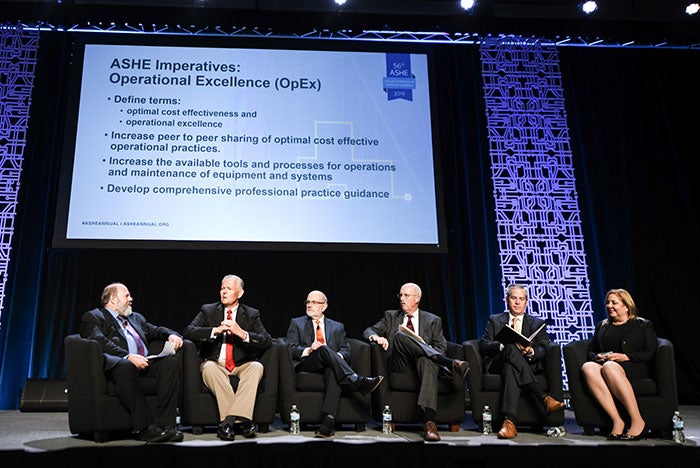ASHE conference panel challenges outdated thinking on operational excellence

From left: Tim Adams, Dana Swenson, Rodger Glaus, Michael Hatton, William Tinsley and Kara Brooks at the 2019 ASHE Annual Conference
Image courtesy of ASHE
Establishing best practices, and defining and achieving operational excellence in health care facilities were main themes today at the 56th American Society for Health Care Engineering (ASHE) Annual Conference & Technical Exhibition.
Tim Adams, FASHE, CHFM, CHC, director of leadership development, ASHE, led this morning’s panel “Operational Excellence Leadership — Investing in the Health Care Physical Environment.” He was joined by Dana Swenson, PE, MBA, SASHE, senior vice president & chief facilities, UMass Memorial Health Care Inc.; Kara Brooks, LEED AP BD+C, sustainability program manager, ASHE; Michael Hatton, MBA, CHFM, RPA, SMA, FASHE, vice president, Memorial Hermann Health System; Rodger Glaus, executive director, facilities maintenance & operations, Mercy Health; and William Tinsley, CHFM, CHC, CEO of Bernhard Energy.
The general session centered on operational excellence as a long-term journey rather than a final destination. The panel also challenged a long-standing idea that has been adopted by many organizations: “Doing more with the less.” Swenson says that if facilities departments must make do with less resources, then leaders should also look to do less as well.
Members of the panel brought up examples of contracting, preventive maintenance, commissioning, training, technology and low-cost improvement projects as just some of the strategies facilities managers can deploy to begin “doing less with less,” without sacrificing quality and patient safety.
The day’s concurrent sessions continued with the theme of establishing best practices. Eric Cote, project director of Powered for Patients, and Jonathan Flannery, MHSA, CHFM, FASHE, FACHE, senior associate director of advocacy at ASHE, led a session on the Powered for Patients initiative.
Powered for Patients is initiative that formed following Hurricane Sandy that hit the East Coast in 2012. Six New York hospitals lost emergency power during the storm, leading to several patient evacuations. Powered for Patients’ mission is to develop an automated dashboard that will alert local, state and federal government bodies when hospitals are in danger of losing emergency power. The automated notification would allow entities to deploy emergency resources before power failure and prevent patient evacuations.
Cote updated attendees on the project’s developments, including hospitals that have signed up as pilot sites; its work with the Los Angeles County Hospital Preparedness Program; development of a dashboard that will signal red, yellow and green to signal a hospital’s emergency power status; and a map of the United States that tracks weather disasters in real-time.
Cote also discussed working with technology providers to help develop dashboards that can relay emergency power status to government officials without revealing detailed data. He also said the initiative is working with accrediting organizations to obtain formal agreements on hospitals’ privacy concerns on how the data will be used.
Flannery says that ASHE has been a partner in the project since its earliest days, and stressed the importance of quicker deployment of emergency resources during times of disaster.
“ASHE is very serious about best practices,” he says. “We saw this as an opportunity to go above and beyond what the code says we have to do and have an actual best practice that protects patients.
“If there is an issue with the generator, they can start to process communication to get a replacement to the hospital before it goes to failure” Flannery continues. “Once it fails, now you’re evacuating in the middle of a storm with no lights and carrying patients down 20 flights like what happened in New York City. It’s worth noting that there wasn’t a single patient injury or death due to evacuation, and that is a very good thing. But it would have been better if there were no evacuations at all. That would have been best for our patients.”
Read coverage from Day 1.

